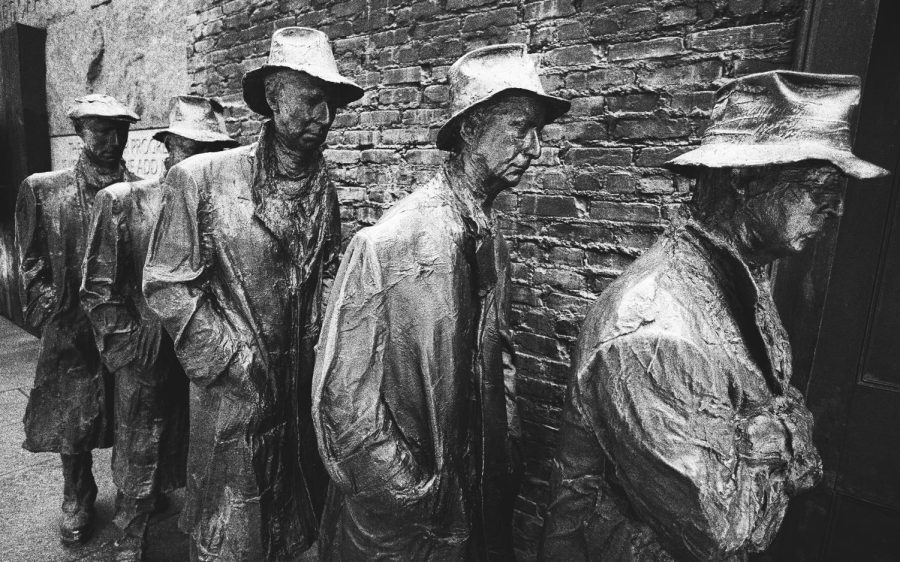Historically Speaking: From riches to rags to world leadership
Part of the Franklin D. Roosevelt Memorial in Washington D.C., pictuted in December 2018, represents the depths of the Great Depression. (Photo by Sonder Quest via Unsplash)
March 11, 2023
Writer’s Note: As “dire” as you think things are today in 2023 with our inflation-ridden life, in general could be worse … and they were just throughout the 1930s. Hopefully, we won’t repeat those days, but somehow history has a way of repeating itself.
The Great Depression that plagued the entire third decade of the 20th century took less than a decade to create. Stock market speculation frenzy during the “Roaring” 1920s caused vast numbers of Americans to feverishly borrow money in order to buy stocks to get rich quick.
Unlike today’s stock market, which has stringent federal safeguards, the Roaring ’20s brought about wild speculation and false optimism.
By 1928, stockbrokers had loaned investors some $800 million. By October 1929, this tremendous debt caused the market to crash. Investors lost confidence, loans were called in, resulting in a selling frenzy that caused a complete financial collapse. Those who sold their shares lost everything. Ironically, the few investors who held their stocks eventually regained losses.
 Government’s “hands-off” attitude toward American business resulted in unchecked investing and borrowing. The result was an unstable economy, with a false national wealth. By 1930, the United States truly was a “have” and “have-not” nation. Inflation set in, causing prices to rise to the point most Americans could not afford to buy necessities. Farmers and blue-collar workers were among the worst hit, causing a spiraling economy.
Government’s “hands-off” attitude toward American business resulted in unchecked investing and borrowing. The result was an unstable economy, with a false national wealth. By 1930, the United States truly was a “have” and “have-not” nation. Inflation set in, causing prices to rise to the point most Americans could not afford to buy necessities. Farmers and blue-collar workers were among the worst hit, causing a spiraling economy.
Herbert Hoover, who was the secretary of commerce from 1921 to 1929, took office as president in 1929. As president, Hoover would have only a few months of prosperity. By 1932, other developed nations had followed, and the entire world plunged into economic chaos.
By March 1929, Americans couldn’t have been more confident about their new president. America was booming with a vibrant stock market and a strong, bustling industry — what could go wrong?
But by 1931, Europe was plunging into crisis and chaos. President Hoover presented a program for aiding American businesses and farmers, many of whom were facing foreclosures on their properties. He also proposed banking reforms as well as federal loans to individual states so they could feed their unemployed. Hoover also demanded the federal government drastically cut its own spending wherever possible.
Hoover felt no one should go hungry, but it was the responsibility of individual states, local governments and private volunteer organizations — not the Federal government — to help. This philosophy would be his political ruin.
Hoover’s failed presidency culminated with the mass march of World War I veterans on Washington, D.C., creating the “Bonus Army.” It was the election year of 1932. The demonstration in the nation’s capital climaxed on July 28 when the U.S. Army was called out by Hoover to put down the veterans’ demonstration.
The Bonus Army was made up of 17,000 U.S. World War I veterans, together with their families and affiliated groups, totaling an estimated 43,000. They gathered and camped out on the Capitol Mall to demand early cash redemption of their service bonus certificates promised to them by Congress.
Hoover ordered the U.S. Army to clear the marchers’ campsite. Gen. Douglas MacArthur commanded a contingent of infantry and cavalry, supported by six armored tanks, and the Bonus Army was driven out and their shelters burned.
Unless one lived through the Great Depression, there’s no way to fully explain what life was like for the average citizen. Those Americans living in the rural areas had plenty to eat because they grew most of what they needed. Money was the problem. In the cities, families starved as unemployment reached 40%.
In 1932, Franklin D. Roosevelt was elected president promoting a “New Deal.” Ironically, much of Roosevelt’s “New Deal” was based on programs designed by Hoover. Today, historians argue whether FDR’s economic programs ended the depression. But it’s a moot point … it was World War II that put the nation and the world back to work.
In May 1940, FDR and British Prime Minister Winston Churchill met as the president continued to maintain U.S. neutrality. FDR placed an oil embargo against Japan, cutting off their critical petroleum supply. They retaliated on Dec. 7, 1941, bombing Pearl Harbor.
Roosevelt did something no other president had done. During the ’30s, he began talking on the radio with his “Fireside Chats,” circumventing the rest of the media. In 1940, FDR explained his “Lend-Lease” plan: “My fellow Americans … England stands alone. … We cannot and will not tell them they have to surrender simply because we will not give them the weapons they need. If Great Britain goes down, all of us will be living at the point of a Nazi gun. … I understand what England’s needs are and I understand what the dangers are.”
Sound familiar? The build-up toward the second World War had one redeeming aspect — war production effectively ended the Great Depression. Roosevelt told listeners that America must become the “great arsenal of democracy.” … “Let no man say it can’t be done … it must be done!”
After the Japanese attack on Pearl Harbor, factories across America retooled, turning out more than 60,000 warplanes, countless tanks and guns. By 1943, the number of aircraft rose to 125,000. By 1945, the U.S. was producing a bomber every 30 minutes and one troop-carrying liberty ship every 30 days. Some 16 million Americans were in uniform. By 1946, more than 1 million uniformed Americans had lost their lives.
FDR did not live to see the end of hostilities. He died on April 12, 1945, less than one month before Germany’s and five months before Japan’s surrender.
While some may view this story in a negative way, the Great Depression and World War II were America’s entrance into world leadership. The War saved America from the Great Depression.
Tom Morrow is a longtime Oceanside-based journalist and author.
Columns represent the views of the individual writer and do not necessarily reflect those of the North Coast Current’s ownership or management.




